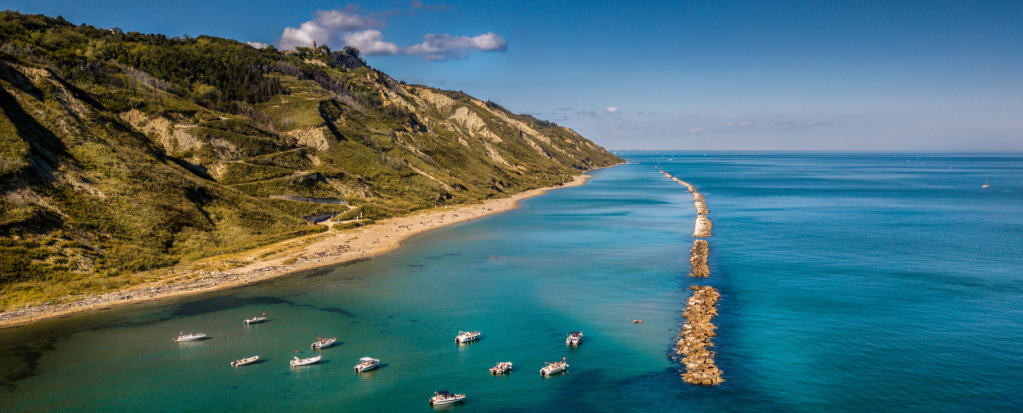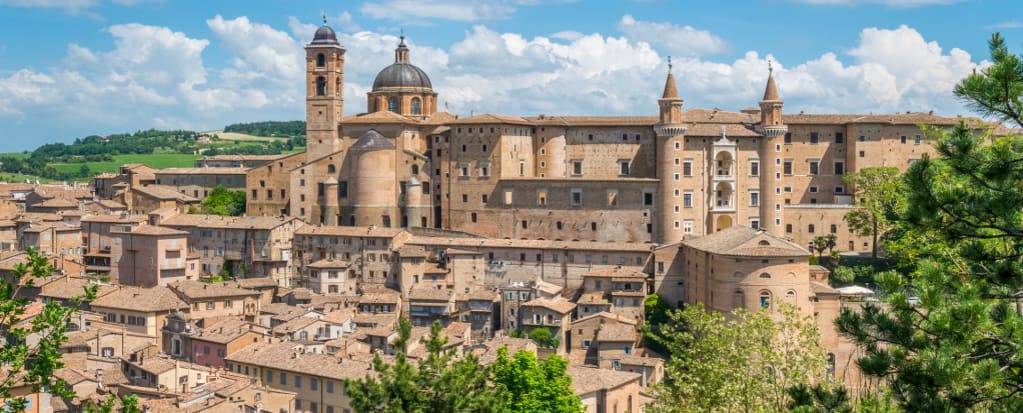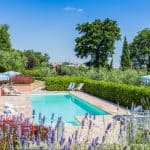Well-known destinations, unspoilt villages, natural and artistic beauties waiting to be discovered. Discover with us the best destinations in the province of Pesaro and Urbino, where sea and nature combine with the charm of historical and artistic beauties.
The province of Pesaro and Urbino is located in the northern part of the Marche region, an area with a particular geographical conformation that combines the beauty of the Adriatic Sea with the green hills of the Marche region. There is no shortage of natural and artistic beauty and charming historic villages where time seems to stand still.
Follow this guide to discover the destinations you absolutely cannot miss during your stay in an holiday home in the province of Pesaro Urbino for a pleasant holiday among culture, nature and food and wine.
1) Pesaro, the city of music and cycling
The birthplace of the composer Gioacchino Rossini and characterised by an extensive network of cycle paths, Pesaro is a thriving seaside and industrial town overlooking the Adriatic Sea.
The city, founded by the Romans, lies between two coastal hills: Monte San Bartolo and Monte Ardizio.
Pesaro has a centuries-old tradition of seaside hospitality thanks to the seven kilometres of sandy beach to the south and the San Bartolo and Ardizio hills to the north. The seaside offer can satisfy the needs of everyone, from families with children to groups of young people, thanks to the numerous fully equipped establishments and small bays surrounded by nature.
The seafront promenade of Viale Trieste, full of bathing establishments and clubs, is perfect for a summer stroll or a sunset aperitif.
Pesaro is one of the cities where the sun rises and sets over the sea. You might be wondering where the best place to admire the sunrise and sunset is, right? Definitely Baia Flaminia and the “Molo di levante”, where you can lose your eyes in the beauty of the colours the sky offers while enjoying an aperitif.
From Viale Trieste you can easily reach Piazzale della Libertà and admire the Sfera Grande by sculptor Arnaldo Pomodoro. This square is a very lively place where many musical and sporting activities are organised
Moving towards the centre, you will find Via Rossini, named after the famous music composer Gioacchino Rossini, who remained linked to the city throughout his life. Here you can visit the house where he was born, now a multimedia museum, and the splendid Teatro Rossini where the ROF, one of the world’s most famous opera festivals, is held every year. Continuing on, you will reach Piazza del Popolo, at the centre of which is the beautiful fountain, ‘La Pupilla di Pesaro’.

La Sfera Grande by Arnaldo Pomodoro
San Bartolo, the green heart of Pesaro
Mount San Bartolo gives its name to the natural park of which it is part and is definitely one of the things not to be missed in Pesaro.
Here you will find a breathtaking panorama overlooking the Adriatic Sea. The park, which covers an area of 1600 hectares of trails, is perfect for nature walks and bird watching. In addition, there are many historical villas along the Panoramic Road, including Villa Caprile, which comes alive in summer with tourists visiting its beautiful terraced Italian gardens.

San Bartolo Park
2) Urbino, Renaissance and university city, Unesco World Heritage Site
Among the rolling hills of Montefeltro lies Urbino, the birthplace of painter Raffello Sanzio.
A UNESCO World Heritage Site since 1998 and a city rich in art and history, Urbino is the perfect combination of the past thanks to its warm Renaissance atmosphere and the future due to the large number of university students who populate the city throughout the year.
The first thing to do as soon as you arrive in Urbino is to visit the magnificent Ducal Palace, emblem of the Italian Renaissance. Once the home of Federico da Montefeltro, it is now the seat of the National Gallery of the Marche region, which houses important works of art created between 1300 and 1600, including those by Raphael, Piero della Francesca and Paolo Uccello.Next to the Ducal Palace you will find the Cathedral of Santa Maria Assunta, rebuilt by the Sienese Francesco di Giorgio Martini in the Renaissance style. The Cathedral has a floor plan with three naves and neoclassical decorations, punctuated by the altars of the side naves where valuable paintings are displayed.
Walking through the alleys of the city, you will reach the Oratory of San Giovanni where you can admire a cycle of frescoes depicting the crucifixion and the Stories of the Life of St John the Baptist painted by the brothers Lorenzo and Jacopo Salimbeni in 1415. You will certainly be impressed by their scenic presence and colours
A few steps away you can visit Raphael’s birthplace, built in the 15th century, which houses a fresco depicting “The Madonna Child” and where the painter learned his first painting lessons.
Continuing along Via Raffaello, up the steep slope you will find yourself in front of the monument dedicated to the artist, born in Urbino in 1483. Raphael lived his youth in this city, which largely influenced his works, all characterised by a unique spirituality.
A few more steps and you will have a wonderful panorama in front of you. Walk up to the Albornoz Fortress, a building from the second half of the 15th century, and admire the city from above.
A favourite place for university students to relax between study sessions while admiring the dome of the cathedral, the small towers of the Ducal Palace and the Marche countryside.

Urbino Ducal Palace
3) Fano, Roman and maritime city
Overlooking the Adriatic Sea and not far from the mouth of the Metauro River is Fano, an ancient Roman colony rich in art and culture. Very popular in summer as a seaside resort thanks to its numerous bathing establishments and lively nightlife.
A visit to Fano must start at the Arch of Augustus, the gateway built by the Romans in 9 AD during the Augustan Empire, which gives access to the city.
Lose yourself among the shop windows of Corso Matteotti until you reach Piazza XX Settembre, the heart of Fano. Here you will find the Palazzo del Podestà, now converted into the Teatro della Fortuna, and the Palazzo Malatestiano, home to the Museo Civico.
Fano’s strong point is its coastline. Divided between Lido and Sassonia, it can satisfy the needs of everyone. The Lido is characterised by fine sand and shallow waters, perfect for families with children, while the Sassonia beach, with its pebbles and deeper waters, is perfect for lovers of water sports such as sailing and windsurfing.
Fano pays particular attention to four-legged friends. On the Arzilla beach you will find two areas reserved for dogs: “The Animalindo Dog Beach” and “Islamorada” where you can bathe with your dog in an area delimited by buoys.
For the more romantic there is the Passeggiata del Lisippo, a pathway on the rocks supported by a metal structure that reaches the middle of the sea at the end of which is a copy of a Greek work of art by the sculptor Lisippo, recovered by Fano fishermen in 1961.
One of the most eagerly awaited events in Fano is the Carnival, the oldest in Italy. For a month, the city comes alive thanks to the atmosphere of festivities typical of Carnival. For three Sundays you can watch the parade of allegorical floats through the city centre where the traditional throwing of sweets and candy takes place.
You cannot leave Fano without having tasted the Moretta, a drink made from coffee, a mixture of spirits and lemon peel, and Brodetto, a fish soup traditionally cooked by fishermen at sea. Every year in September, the BrodettoFest takes place where you can enjoy tastings, cooking shows and fun with friends.
4) Gradara, the most beautiful village in Italy
Gradara is a small village on the border between the Marche and Emilia Romagna regions, characterised by its medieval atmosphere and breathtaking scenery.
As soon as you arrive, you will be surprised by the walls that protect this village. From Porta Firau you can access the town, walking along the main street you will reach the Malatesta fortress, built in 1150, behind which lies the entire history of the town and the families that ruled it: Malatesta, Sforza and Della Rovere. Gradara Castle is fascinating both for its historical and architectural value and for the suggestion of the love story between Paolo and Francesca, which seems to have taken place inside. Here you can visit numerous rooms adorned with works of art of great value.
Among the things not to be missed in Gradara are the “Lovers’ Walk”, a pedestrian path through a small wood surrounding the castle; the Historical Museum, rich in torture instruments and medieval weapons; the Olive Garden, an ideal place to relax and admire centuries-old olive trees.

Gradara
5) Gabicce, the town between sea and mountain
Situated on the border between the Marche and Emilia Romagna regions, Gabicce has a decidedly strategic position between the sea and the mountains that can satisfy the needs of everyone.
Gabicce Monte has Roman origins and is located on Mount Accio on the border with Emilia Romagna.
The centre of the village is in Piazza Valbruna with its ancient streets, restaurants and shops.
Gabicce Monte is immersed in the San Bartolo Park. From the village, through the “Sentiero del Coppo” it is possible to get directly to the sea.
Gabicce Mare, on the other hand, is located on the Baia degli Angeli (Bay of Angels) along the last part of the Gulf of Rimini. Beaches 2 kilometres long of fine sand and pebbles characterise this coastline, which has been a Blue Flag winner since 1987. The beach offer is very rich thanks to the 40 bathing establishments that offer excellent services perfect for families with children as well as for young people.
Also worth a visit is the coast of Vallugola, a natural inlet with crystal-clear water.
Both resorts are perfect for family relaxation and for lovers of trekking, cycling and water sports.
6) Monte Grimano Terme
At 500 metres above sea level, among the hills of the Conca Valley in Montelfeltro, stands the village of Monte Grimano Terme.
Developed around a castle that no longer exists, the village is now characterised by the 18-metre high civic tower in the historic centre. Inside there are often exhibitions of various kinds and three reading rooms that refer to the “LiberaLibri” project. This village is renowned for its love of books, and in fact there are 20 book crossing stations in the municipality, i.e. small lilac wooden houses where people can leave and take books for free.
Not far from the village, on a 900-metre hill, are the thermal baths which are part of the “Centro Salute Erba Viva” spa. They exploit the sulphurous and alkaline waters that flow from the slopes of Monte San Paolo. From here you can admire a wonderful panorama that goes from the Apennines to Pesaro and Cesenatico. The thermal baths are the ideal place to find harmony of body and mind thanks to the different methods and numerous natural treatments.
7) Mondavio, the most beautiful village in Italy and Fratterosa
In a strategic position, on a hill 280 metres above sea level, lies Mondavio. Nominated as one of the most beautiful villages in Italy and certified with the Orange Flag by the Italian Touring Club, Mondavio is protected by the Rocca Roveresca, an imposing example of Renaissance defensive construction built in 1482 by the architect Francesco Di Giorgio Martini.
Inside you will find reconstructions of rooms and scenes of daily life together with reconstructions of war machines.
We recommend you then head for Piazza Giacomo Matteotti where you will find the church, the cloister of San Francesco and the Town Hall.
Wander through the streets until you get close to the moat, under the Rocca Roveresca, to admire reproductions of war machines.
Not far from Mondavio, we also recommend a visit to Fratterosa, a small village on a hill between the Cesano and Metauro valleys.
The village is famous for its centuries-old activity of making handcrafted terracotta, unique in shape and colour. It is possible to visit the Terracotta Museum inside the Convent of Santa Vittoria where you will find their history, from the raw materials, to the workmanship up to the actual making of the objects, also called “cocci” of Fratterosa.
Finally, stroll through the streets of the town surrounded by walls and admire the panorama that reaches as far as the sea.

Mondavio
8) Frontone at the foot of Mount Catria and the Fonte Avellana Monastery
Frontone is a small medieval village surrounded by greenery at the foot of Mount Catria.
Mount Catria is the mountain that overlooks the Cesano valley, 1701 m above sea level and is part of the Umbria-Marche Apennines.The Cesano river and the Cinisco torrent rise from this mountain. Thanks to asphalted roads, it is possible to reach the summit, from where there is a beautiful view as far as the Adriatic Sea.
It is the perfect destination for skiers, thanks to the ski resort in the municipality of Frontone, with 9 km of slopes and ski lifts, but also for those who love walking, trekking and mountain biking, thanks to the numerous paths of varying degrees of difficulty that offer everyone the chance to enjoy days in nature and wonderful views.
At the top of Monte Catria there is a metal cross commissioned by Pope Leo XII in 1900, the symbol of the mountain. This can be reached on foot in about 45 minutes starting from the Vernosa refuge.
Now let us return to talk about the village of Frontone. Its symbol is undoubtedly the Castello della Porta, a stone building constructed in the 11th century to defend the territory.
Once you arrive in the small hamlet, lose yourself in the narrow streets and admire the splendid panorama of the Marche hills and mountains.
If you want to relax, breathe clean air and spend moments in total tranquillity, Frontone is definitely the ideal place for you.
You cannot leave the village without having tasted the typical “Crescia” and the many local specialities in one of the characteristic restaurants.
Not to be missed in winter, inside the Castle and in the streets of the historic centre, is the Christmas market “Nel Castello di Babbo Natale”.
Near Frontone, in the municipality of Serra Sant’Abbondio, is the beautiful Fonte Avellana Monastery. The abbey was founded by a group of hermits at the end of the 10th century.
We recommend a guided tour inside the Monastery to take a step back in time and visit the Library, the Hall of San Giovanni da Lodi with the Scriptorium, the Cloister and the Crypt, the oldest part of the Hermitage.
Fonte Avellana is also suitable for trekking enthusiasts: there are in fact numerous paths of varying degrees of difficulty that are also suitable for those who simply want to enjoy a walk in nature.
9) Acqualagna, the Truffle capital
Acqualagna is a small town between the Burano and Candigliano torrents on the slopes of Monte Catria and Nerone.
The town is also known as the Truffle Capital because of the ancient activity of research and production of this tuber, which is present all year round thanks to the type of climate and soil.
In the main square of the town you will find the War Memorial, the Town Hall, “Enrico Mattei’s Birthplace”, Palazzo Conti, home of the Truffle Museum where you can take a journey of discovery of the truffle in 3 steps: discovery, initiation and rarity.
Acqualagna is immersed in the Gola del Furlo State Nature Reserve, an area crossed by the Candigliano river that flows through the rocky walls of the Gola Del Furlo. The Reserve offers a very suggestive landscape combined with a naturalistic richness that boasts examples of flora and fauna such as golden eagles, hawks and herons.
Inside you will find La Golena Park, an ideal place to organise an open-air picnic
For sports lovers, the Furlo Adventure Park consists of three acrobatic courses and is perfect for children.

Gola del Furlo State Nature Reserve
10) Pergola, the town of the Golden Bronzes
We find ourselves in another small town capable of offering cultural beauty and food and wine delicacies.
Recognised as “one of the most beautiful villages in Italy”, Pergola is a municipality in the Upper Cesano Valley.
The roots of this village date back to prehistoric times. Its history is perfectly documented in the Museo dei Bronzi, created in 1999 and divided into four sections: The Bronzes, The Picture Gallery, Numismatics and Contemporary Art.
Of particular importance is the group of life-size gilded bronze statues dating from 50 B.C., discovered in 1946 by two farmers. These are the only surviving group of gilded bronze sculptures from Roman times.
Close to the Museum is the Cathedral of Pergola, dedicated to Saints Andrew the Apostle and the Second Martyr, built in 1285.
Another corner of paradise in Pergola is the natural Valrea waterfall, which is easily reached on foot along a path a few metres long after leaving the car nearby.
Every year, Pergola hosts Animavì, the International Festival of Poetic Animation Film, which has been awarded a medal of representation by the President of the Republic, Sergio Mattarella.
Like Acqualagna, Pergola is also known as the Truffle City all year round. Here the “diamond of the table” can be enjoyed all year round.
Not to be missed is the Fiera del Tartufo Bianco Pregiato (White Truffle Fair) held in October, which became national in 2013.
11) Cagli, a Roman village at the foot of Mounts Petrano, Catria and Nerone
Between the rivers Bosso and Burano, surrounded by Mounts Petrano, Nerone and Catria lies Cagli.
The small town has maintained its medieval historical identity. One of the most important monuments is the Torrione by Francesco di Giorgio Martini, built in 1481. This structure was part of a system of fortifications built during the Montefeltro domination and includes not only the Rocca but also an underground walkway of 360 steps, which can still be walked today. Today, the Torrione houses the Contemporary Sculpture Centre with works by international artists such as Eliseo Mattiacci, Jannis Kounellis, Giulio Paolini, Giuseppe Uncini, Marco Gastini, Gilberto Zorio, Ernesto Porcari and Paolo Icaro.
A short distance away, in the heart of the town, is the beautiful Church of San Francesco, the oldest Franciscan church in the Marche region. Nearby, the evocative Basilica of Santa Maria Assunta.
If you love the river, you cannot miss a dip in the gorge of the Burano River, perfect for cooling off on hot summer days amidst small waterfalls and natural pools.
A beautiful summer event in Cagli is the ‘Giuoco dell’Oca’, a historic palio that has been held since 1543. This event is held every year on the second Sunday of August and is characterised by parades in medieval costumes, games and the opening of food and wine taverns.






